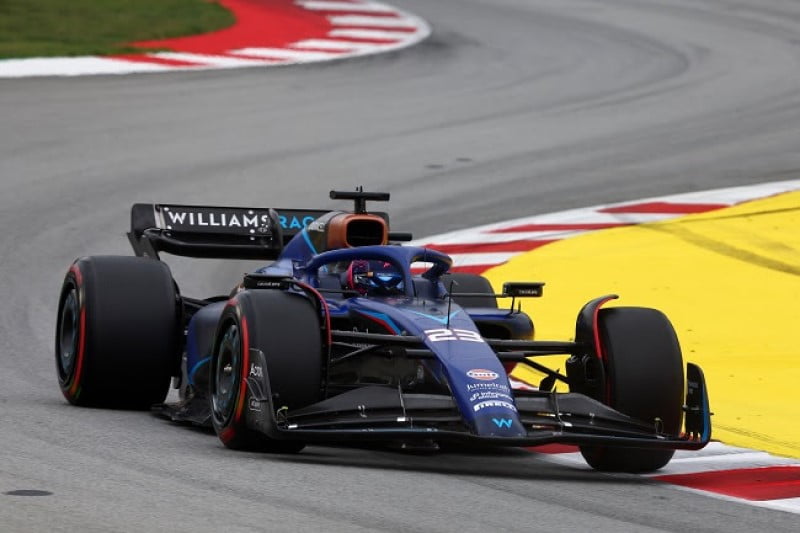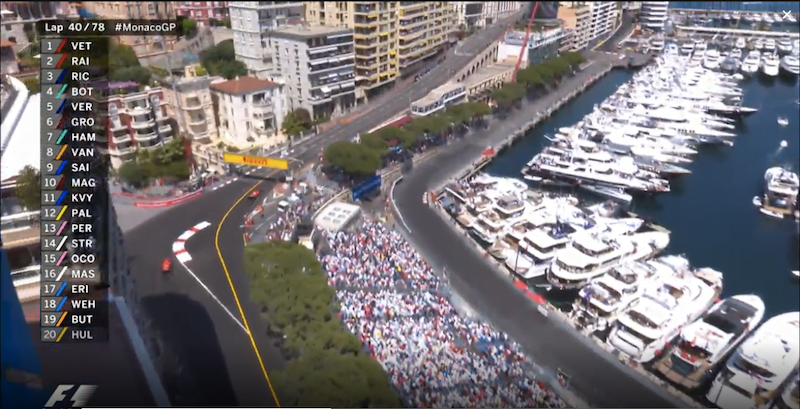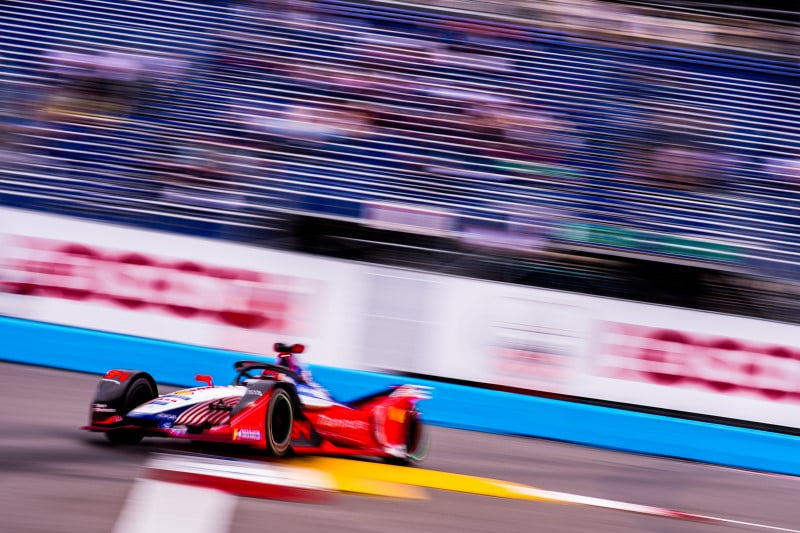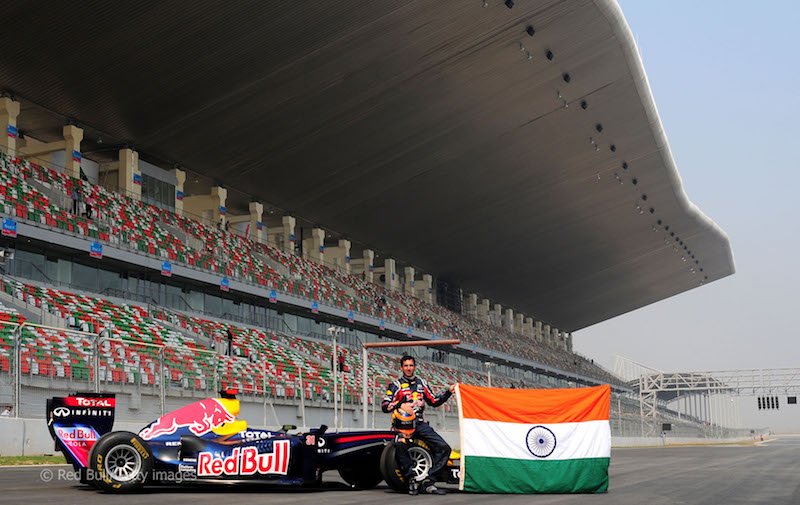2023 Spanish Grand Prix
Budding Formula 1 tech-journalist Ashwin Issac pens his ‘F1 Midfield Tales’ from the 2023 Spanish Grand Prix. ‘F1 Midfield Tales’ will be a combination of data and analysis that will aim to dissect the uber-competitive F1 midfield race-after-race.
Preface
The freights and flights, supercars and superbikes, all had one destination: the Circuit de Barcelona-Catalunya in Montmeló, Barcelona, Catalonia, Spain for the AWS Gran Premio De España.
A familiar track etched into the muscle memory of the drivers. This year they had to slightly change their perspective of this track because of a layout change. A change dictated by a need for overtakes. The lethargic chicane, touted by some as the worst corner complex in the calendar, was eliminated for a swooping two-turn curve leading to the start-finish straight.
This configuration of the track is not a new entity in the world of Formula 1, it was originally designed this way with only Fernando Alonso having experience in this layout. What this meant for the drivers and team was that they had to deal with another fast right turn adding more stress on the front left tyre, this track was already a front-limiting circuit, and with the lack of respite offered by the chicane the wear on tyres only increased.
The changes made to the track were an improvement as it did allow a great run on the car ahead for a chance of overtake and there were a lot, in fact, there were 107 overtakes, which is a significant number for this circuit. The high degradation forced the teams to make at least two stops even on cooler conditions of race day.
Amazingly this was the first permanent track of the calendar and it was the most anticipated one because of the upgrades, Almost all the teams had something new on them that was slated to be scrutinised on this proving ground. It must be said that the Williams had the most minor upgrades regarding the midfield.
Let’s ponder how the weekend revealed itself and how the teams fared with their updates.
Observations from the F1 Mid Field in Spain
For the comparisons, data with similar variables are selected to make a viable analysis. For instance, the fastest sectors by a team and not individual drivers are considered for the qualifying examination. Lap times are collected for the same tyre compound at identical race periods.
Qualifying (focusing on the F1 Mid Field in Spain)
Coming off a perfect Friday, the teams had collected valuable data and were ready to unleash their performance when it mattered on Saturday but the weather system around Barcelona had different plans. Rain was speculated but was not guaranteed, the rain did arrive skewing FP3 runs but held off before the qualifying session. The track was dry but the damage had already been done with the rubber washed off the track and most significantly the track temperature had dropped to 24°C, a difference of 15°C compared to Friday.
A spanner was thrown among the works with drivers struggling to switch their tyres on which produced some upsets and surprises.
The surprise was the performance of the McLarens, who were almost the second-fastest team for qualifying.
Here’s a look at how things unfolded:
Due to the green track conditions and lower temperatures, there was a lot of time left on the table by many drivers, most of the grid didn’t string together their fastest sectors and some couldn’t even set competitive times.
Below is a clustered bar chart representing the gaps of each driver in each sector with Lando Norris as the benchmark as he was the fastest among the midfield.
The deficit for each sector is represented by the bars. In contrast, the green line represents the difference between the potential team lap and the registered fastest lap of a driver and the red line represents the difference between the potential driver lap and the registered fastest lap of a driver.
Potential Team Lap: It’s the total of all the fastest sectors set by a team as a whole in the qualifying session.
Potential Driver Lap: It’s the total of all the fastest sectors set by the individual driver in the qualifying session.
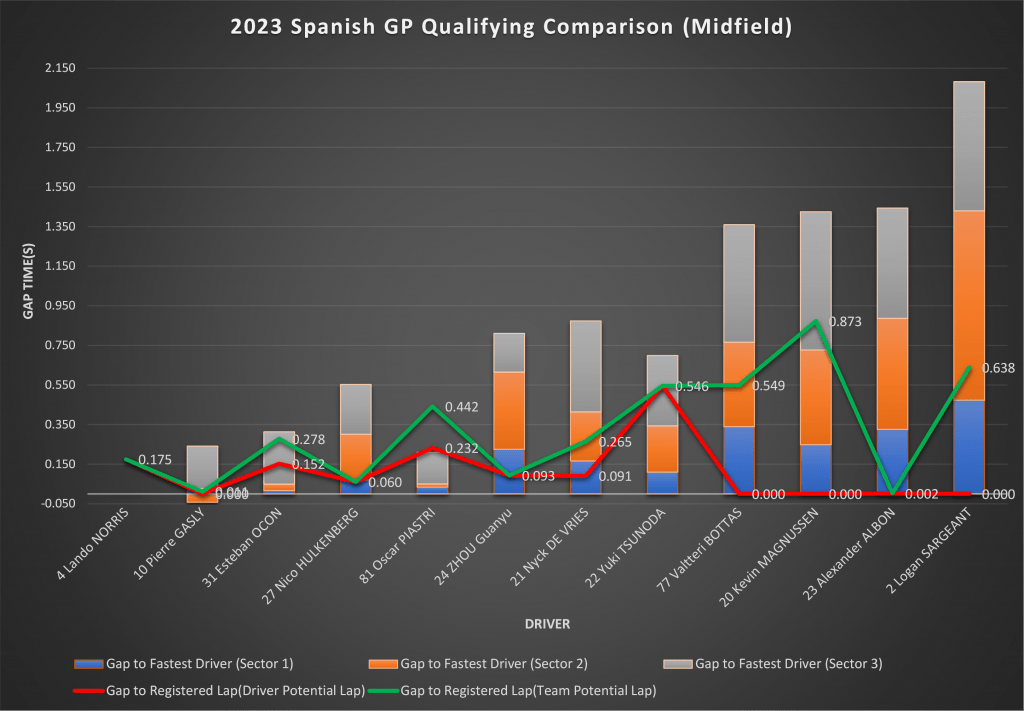
It is observable that:
- Norris missed out on P2 by not stringing his best sector times together, Piastri too left a lot of time on the table even when compared to his personal potential lap.
- It seems Gasly maximised his and the car’s potential for that session but Ocon didn’t. Gasly was even faster than Norris in the second sector.
- The most significant discrepancy between drivers was in the Haas team where Magnussen was nowhere close to the performance of his teammate, he was off by almost 9 tenths.
- Post-race Bottas complained of an unknown problem with his which could explain his deficit to Zhou who also maximised the performance of the car.
- Nyck took the bragging rights on Saturday over Tsunoda by posting a faster time for the classification but when we combine Tsunoda’s fastest sectors, we find the scale to the lack of consistency on that day.
- After that session, the team that have a lot of work to do are the Williams, even though Albon maximised the car’s potential they were at the bottom of the time sheets.
Carrying on from the analysis above to further understand the characteristics of each car, here is a mini-sector comparison of all the midfield teams. The graph below gives a visualization of each team’s advantages at different segments of the track.
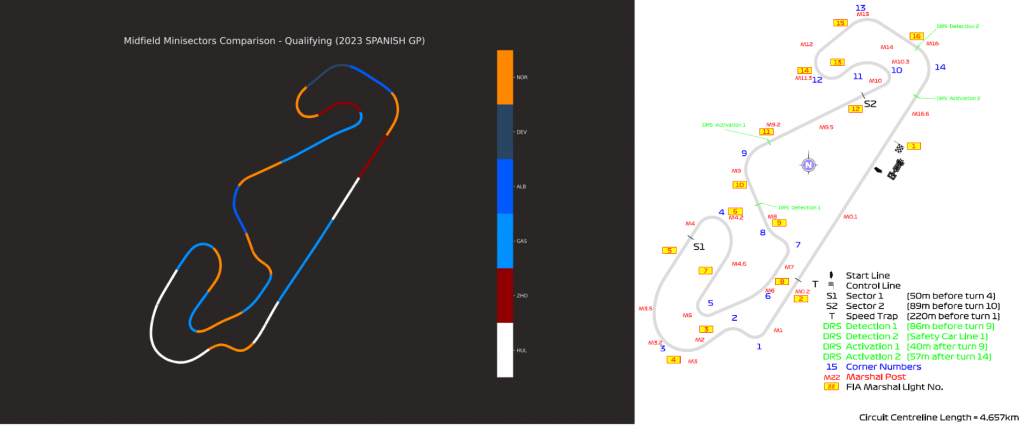
The Race (focusing on the F1 Mid Field in Spain)
On race day there was a threat of rain, all the weather forecasts indicated that it was going to rain before the race ended but the clouds held the waters back. With the cloud cover the temperatures were cooler but not as much on Saturday.
All the midfield drivers started the race on softs and then there was the difference in strategy by different teams. With the high degradation, all three tyre compounds were used as most teams stopped twice with the exception of Haas as they stopped thrice.
Let’s compare the race pace for the teams based on their stints on different tyre compounds. Only the times of the top finisher for each team are considered for the comparison.
- Stint 1 (Soft Tyres)
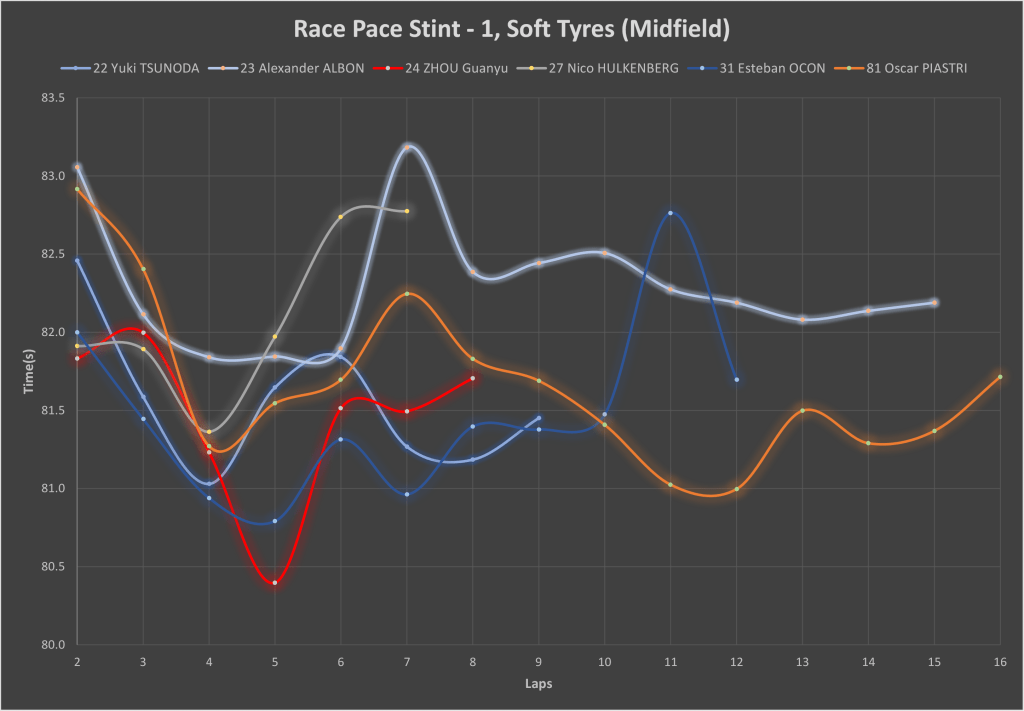
- It is noticeable that all the cars took a couple of laps to bring the tyres to their working window
- Hulkenberg ran the softs for the shortest time showcasing their Achilles heel, which is a high wear rate.
- Piastri used the softs for the most laps, he was initially slow losing a lot of places and then gradually improved his times.
- Ocon was consistently the fastest while Albon was consistently the slowest in this stint.
- Stint 2 (Hard Tyres)
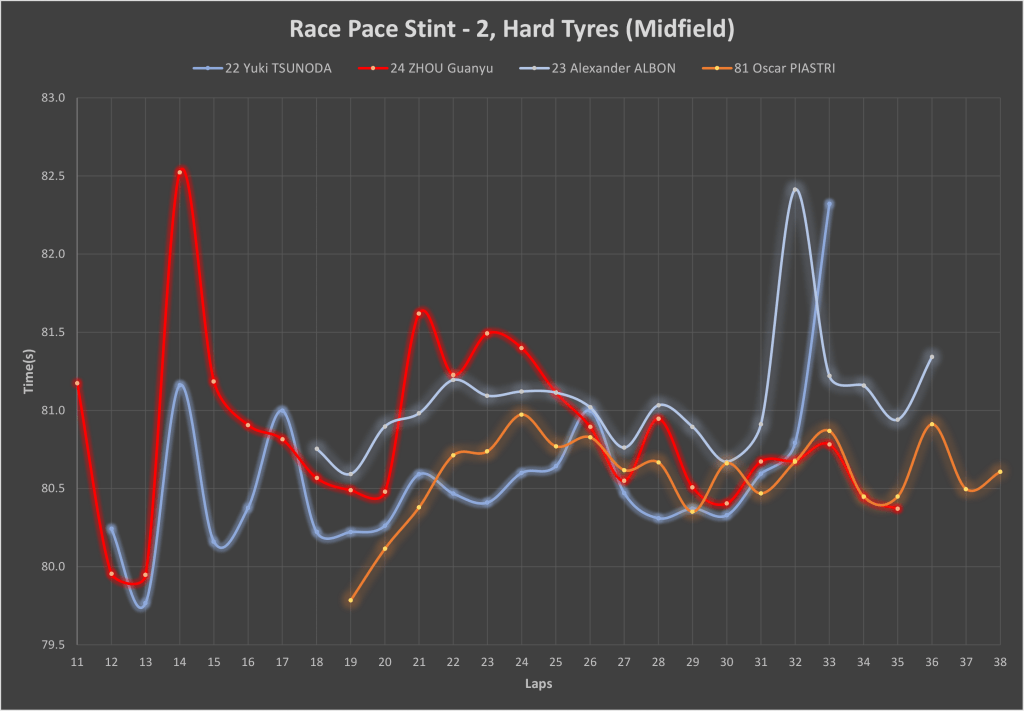
- Alpha Tauri, Alfa Romeo, McLaren and Williams opted for the hard tyres for their second stint.
- Tsunoda was the fastest in this stint closely matched by Piastri.
- Zhou was inconsistent but his times converged at the end.
- Williams again the slowest of the lot.
- Stint 2 (Medium Tyres)
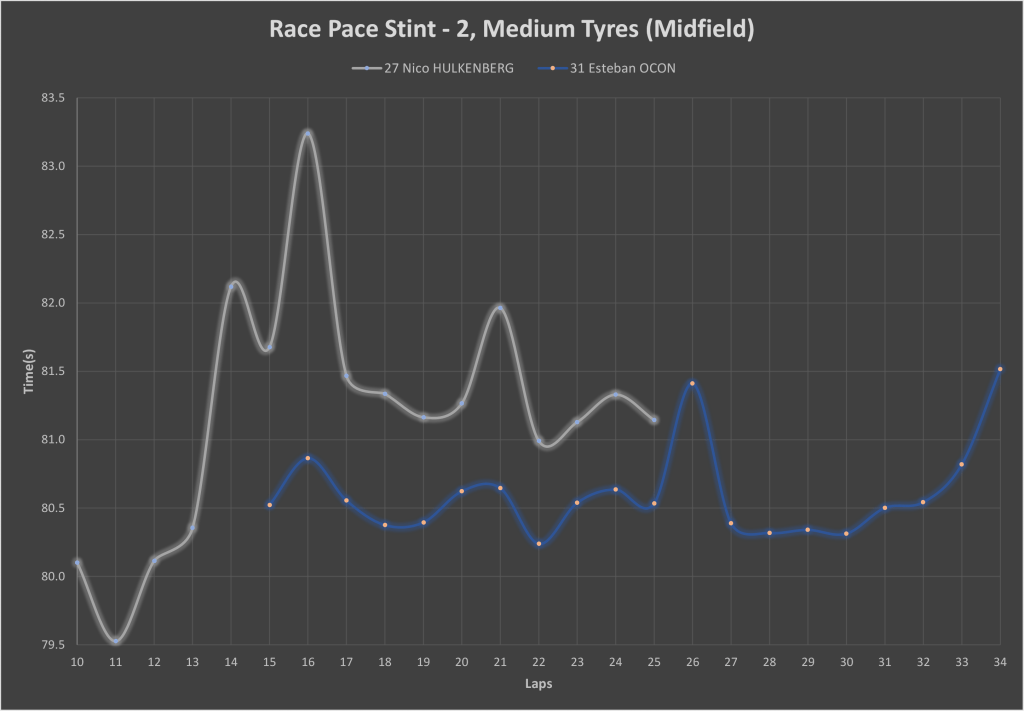
- The difference in pace between Haas and Alpine is clearly evident.
- This is another piece of evidence of the Haas’s wear rate but the one-lap performance of that car is undeniable, when a new set is bolted on they were lighting up the timesheet with purple sectors.
- Stint 3 (Hard Tyres)
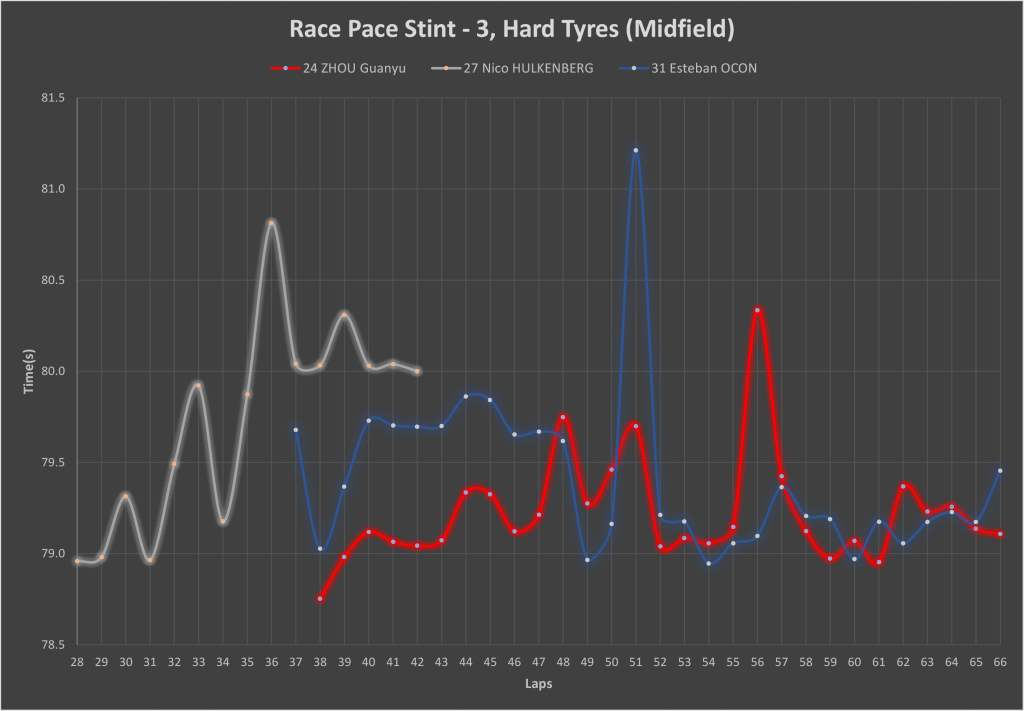
- The Haas characteristics are again replicated. Haas was forced to pit once again for another set of mediums.
- Zhou in the Alfa was faster than Ocon early in this stint and then the times converged.
- Stint 3 (Medium Tyres)
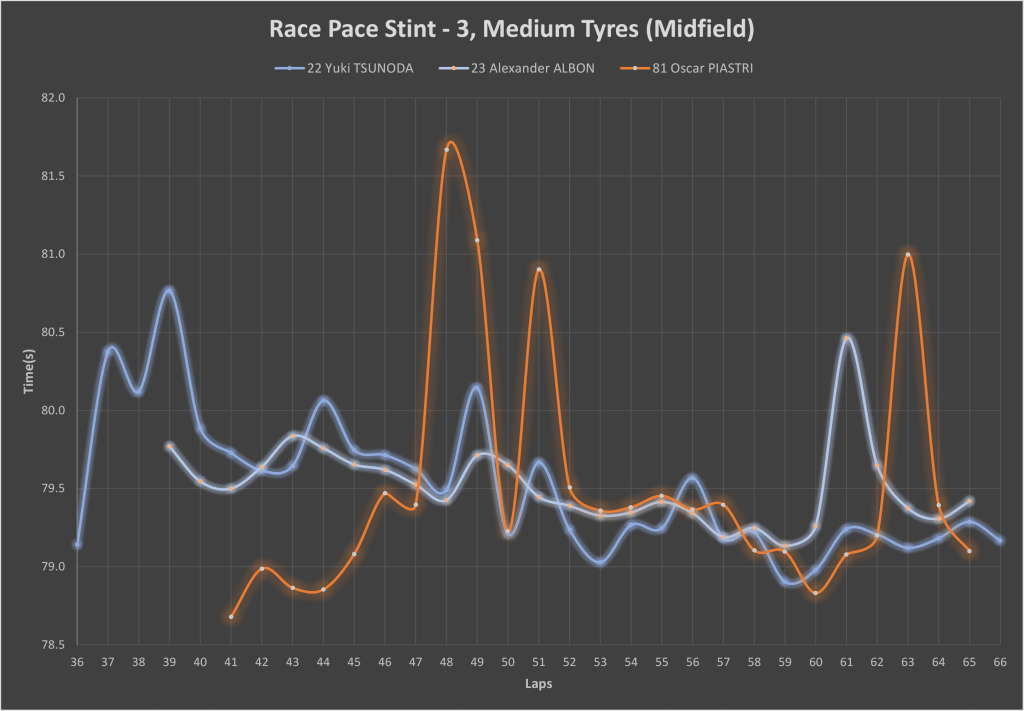
- All three cars had a similar pace to the end of the race but Piastri and Albon were in clearer air.
- Tsunoda maintained this pace while battling for position.
Conclusion
The 2023 Spanish Grand Prix culminated with a very entertaining race which astonishingly had no disturbances to the race, a testament to the discipline of the current group of drivers.
Apart from Williams, all the teams have upgraded their cars and that was clearly evident with the lack of performance put on display by Albon and Sargeant. Albon did give us some clues as to how their car suffers in medium to high-speed corners but their run of recent form unconvinced us. They have a lot of work to do to stay competitive.
Based on this week, Alfa Romeo and Alpha Tauri seemed to have made gains in both their one-lap pace and race pace overall. Tsunoda and Zhou stood out with their execution.
Alpine didn’t have dominance over the rest of the midfield but still remained the team to beat and are knocking on Ferrari’s high doors based on their race pace. They could easily knick a place from Ferrari on Sundays.
Haas, a weapon on Saturdays but a dud on Sundays, attributes that they share with their pseudo-parent team, Ferrari.
McLaren had a stellar Saturday which surprised the entire paddock but they were pulled down to reality on Sunday, they have more upgraded scheduled to come in the near future, if they can find consistency in their performance they will be regularly threatening the top 10.After a week’s break, we head to Canada, a completely different prospect for the drivers and teams. The Formula 1 brigade will be as anxious as ever.
